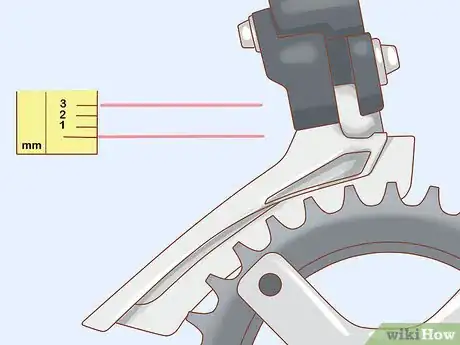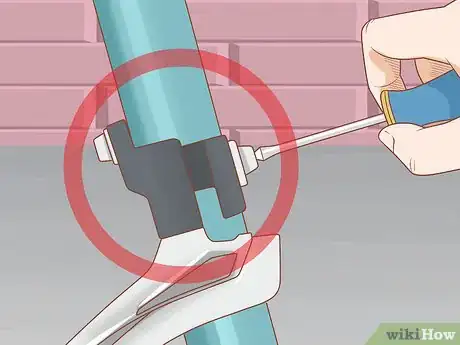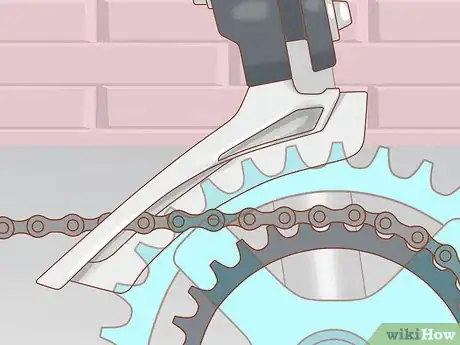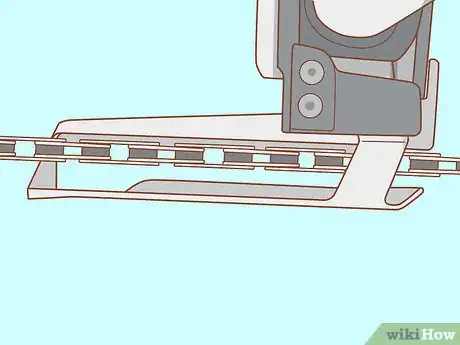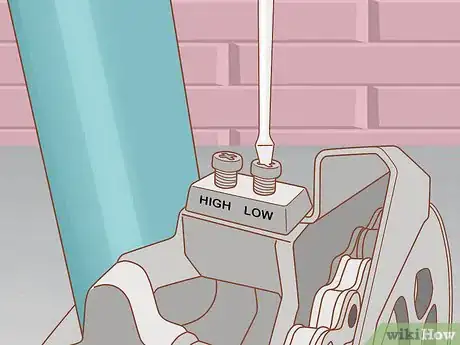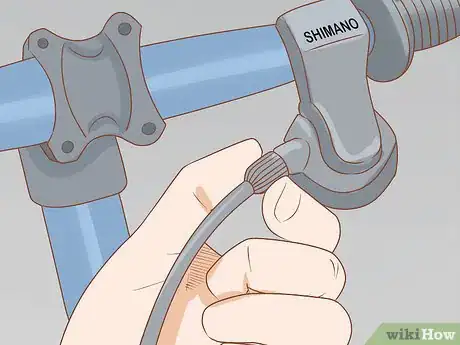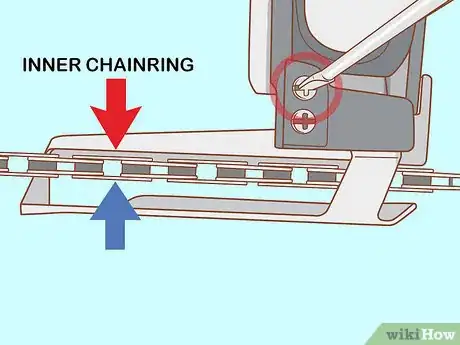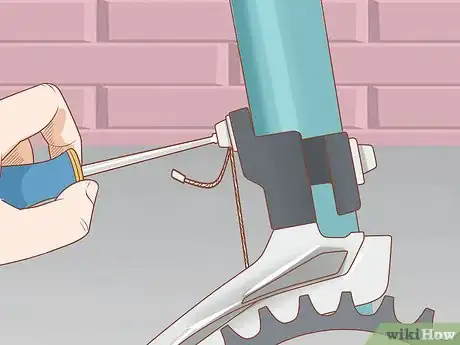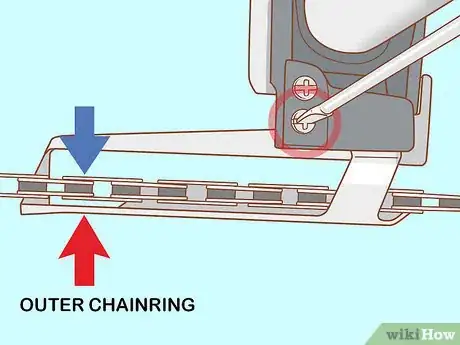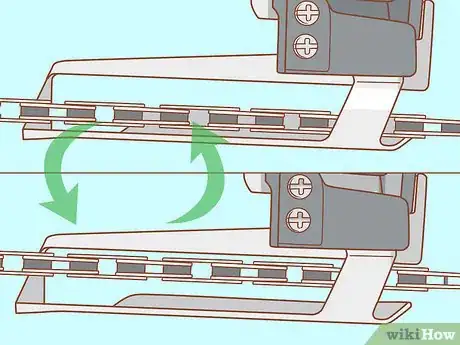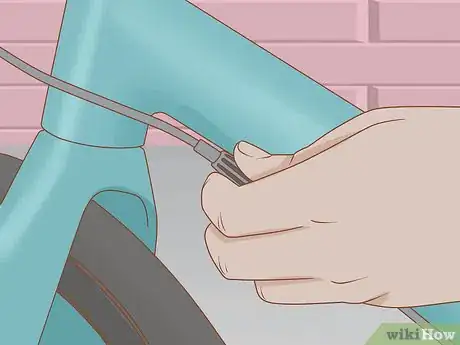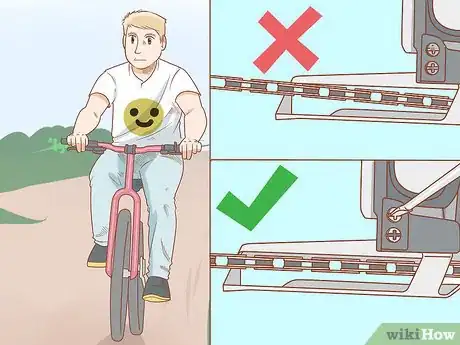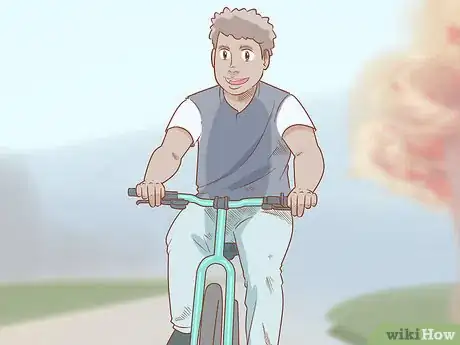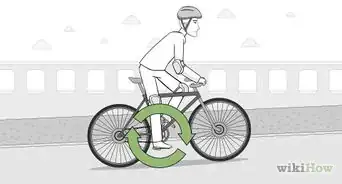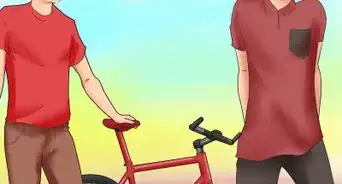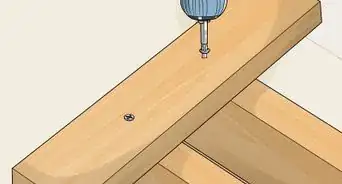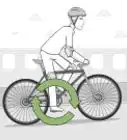This article was co-authored by Jonas Jackel. Jonas Jackel is the Owner of Huckleberry Bicycles, a bicycle retail store based in San Francisco, California. Jonas has over 20 years of experience managing bicycle retail stores and has operated Huckleberry Bicycles since 2011. Huckleberry Bicycles specializes in servicing, repairing, and custom building road, cross, gravel, touring, folding, and e-bikes. Jonas was also previously sat on the Board of Directors for Bike East Bay, a bicycle-advocacy non-profit organization based in Oakland, California.
This article has been viewed 248,664 times.
Any Shimano cyclist knows how frustrating it is to be unable to shift gears just as you are coming to an important point of your ride. The culprit is more often than not a maladjusted front derailleur. When the front derailleur comes out of alignment, it prevents the chain in the bicycle from moving between higher and lower gears. There is no need to panic if this happens and it is actually something that you can fix on your own! All you need is a Phillips screwdriver and about 20 minutes.
Things You Should Know
- Make sure your front derailleur falls about 1-3 mm (0.039 to 0.118 in) above the large chain ring so it doesn't rub against the chain rings or cause a bad shift.
- Adjust the inner and outer limit screws to keep your derailleur cage from going beyond the inner or outer chainring.
- Do a variety of gear shifts on your bike to see if the derailleur works properly without rubbing against the bike chain.
- Make a few counterclockwise quarter-turns with your barrel adjuster to finely adjust the derailleur's position.
Steps
Adjusting the Height and Angle of the Front Derailleur
-
1Make sure your derailleur sits at the correct height. The derailleur should fall around 1 to 3 millimetres (0.039 to 0.118 in) above the large chain ring.[1] When the derailleur cage sits too far above the chainring, this can cause the bike to shift poorly. If it is too far below, the derailleur will rub against the chain rings.[2]
- Fixing the height is a subtle adjustment, based on a difference of millimeters. You will need to be precise. Having your bike on a repair stand can make this work easier.
- You can use a penny to try and estimate if you have adjusted to the right height, as a penny is 1.5 millimetres (0.059 in) thick.[3]
-
2Adjust the height with the positioning clamp. This clamp is what connects the derailleur to the frame of your bike. Loosen the derailleur clamp bolt by turning it clockwise and adjust the height as necessary. Then, tighten the bolt back up.[4]
- This should be done while your bike is on its lowest gear so that there is not too much tension on the inner wire.[5]
Advertisement -
3Check to make sure the derailleur cage is at the right height. Shift to your middle front chainring and see if the cage is sitting properly. If not, shift back into low gear and re-adjust the height with the positioning clamp.[6]
-
4Check to see if the angle of the derailleur is parallel to the chainrings. The derailleur cage and the chainrings should be parallel. If they are not, you will have to make adjustments.
- It is easier to see what adjustments you have to make while you are looking down at the derailleur from above. Envision an alignment between the center of the cage and the centerline of the bike frame.
-
5
-
6Loosen the front derailleur barrel adjuster. Turn the barrel adjuster completely clockwise in order to release tension in the cable. This can be readjusted later on.
Making Limit Screw Adjustments
-
1Set the inner limit screw to prevent the derailleur cage from moving past the inner chainring. Shift the rear derailleur into the largest cog in the back and front derailleur into the smallest cog. Using a screwdriver, twist the inner limit screw until the inner part of the cage is as close to the chain as possible without touching it.[9]EXPERT TIPJonas Jackel is the Owner of Huckleberry Bicycles, a bicycle retail store based in San Francisco, California. Jonas has over 20 years of experience managing bicycle retail stores and has operated Huckleberry Bicycles since 2011. Huckleberry Bicycles specializes in servicing, repairing, and custom building road, cross, gravel, touring, folding, and e-bikes. Jonas was also previously sat on the Board of Directors for Bike East Bay, a bicycle-advocacy non-profit organization based in Oakland, California.Owner, Huckleberry Bicycles

 Jonas Jackel
Jonas Jackel
Owner, Huckleberry BicyclesOur Expert Agrees: Use the high and low limit screws to adjust the tension on the derailleur. Make sure that when the derailleur is in the smallest cog, it won't shift too far, causing the chain to drop off the outside of the cassette. Set the other limit so that you can't shift the chain off the back of the cassette into the spokes. Once the limits are set correctly, adjust the cable tension so the derailleur will correctly shift from one gear to the next.
-
2Adjust cable tension. Loosen the cable that is attached to the derailleur at the anchor bolt. Tighten this cable as much as possible and then make the anchor bolt tight again. It can be helpful to use needle nose pliers while doing this, but you don't have to.
-
3Set the outer limit screw to stop the derailleur cage from moving past the outer chainring.[12] Shift the front derailleur up into the largest chainring and the rear derailleur into the smallest cog. Turn the outer limit screw with a screwdriver until the outer derailleur cage is as close to the chain as possible without touching it.
Making Sure the Derailleur Works Properly
-
1Test to see if the derailleur is shifting correctly. Shift through the whole range of gears on your bike. The derailleur should be able to shift into small and large chainrings without rubbing on the chain.[15]
-
2Use the barrel adjuster to tweak the position of the derailleur. Try twisting the barrel adjuster a few quarters of a turn counterclockwise to fine-tune the position.[16] This will increase the tension so that it shifts into the larger chainring.
- If you can push the derailleur out, it can mean your cable tension is not right. Turn the barrel adjuster to fix this.
-
3Start trimming while you are riding. Trimming means making small adjustments while you are riding your bike. Doing this will help to protect the chain from rubbing against the derailleur.[17] This will prevent the derailleur from coming out of alignment again.
- Shimano bicycles come with a half-click on the lever so that you can make these adjustments easily.
-
4Ride your bicycle as you normally would. Things should be running smoothly now! If the derailleur becomes misaligned again, you may have to do a more thorough job in fixing it next time.
- If you feel like you can´t fix it yourself, you can ask a bike mechanic for help.
Community Q&A
-
QuestionHow do you adjust a front derailleur?
 Drew Hawkins1Community AnswerTo adjust the height of the front derailleur, locate the positioning clamp that connects the derailleur to the frame of the bike. Turn the clamp bolt clockwise to loosen it and then adjust the height. Tighten the bolt once it's adjusted. To adjust the angle of the front derailleur, loose the bolt tht attaches the frame of the bike to the derailleur, shift to the lowest gear of the bike, and turn the derailleur to put it in the right position. Tighten the clamp once you've made your adjustment.
Drew Hawkins1Community AnswerTo adjust the height of the front derailleur, locate the positioning clamp that connects the derailleur to the frame of the bike. Turn the clamp bolt clockwise to loosen it and then adjust the height. Tighten the bolt once it's adjusted. To adjust the angle of the front derailleur, loose the bolt tht attaches the frame of the bike to the derailleur, shift to the lowest gear of the bike, and turn the derailleur to put it in the right position. Tighten the clamp once you've made your adjustment. -
QuestionHow do front derailleurs work?
 Drew Hawkins1Community AnswerA front derailleur on a bicycle moves the chain between the 3 front sprockets. It moves the top part of the chain and allows you to shift into different gears. They're commonly attached to mountain bikes so you can adjust the gears for different terrain to make it easier to pedal the bike.
Drew Hawkins1Community AnswerA front derailleur on a bicycle moves the chain between the 3 front sprockets. It moves the top part of the chain and allows you to shift into different gears. They're commonly attached to mountain bikes so you can adjust the gears for different terrain to make it easier to pedal the bike. -
QuestionShould I adjust the front or rear derailleur first?
 Drew Hawkins1Community AnswerBecause any issues that you're having with your derailleur are likely occurring in the front, start by adjusting there first. If your problem still persists after you make an adjustment, then adjust the rear derailleur. However, if you can tell which derailleur is obviously having an issue, then adjust that one first.
Drew Hawkins1Community AnswerBecause any issues that you're having with your derailleur are likely occurring in the front, start by adjusting there first. If your problem still persists after you make an adjustment, then adjust the rear derailleur. However, if you can tell which derailleur is obviously having an issue, then adjust that one first.
Things You´ll Need
- Phillips screwdriver
- Needle nose pliers
- A penny
References
- ↑ http://www.cyclist.co.uk/tutorials/520/essential-maintenance-front-derailleur-adjustment
- ↑ https://www.instructables.com/id/How-To-Properly-Adjust-The-Front-Derailleur-On-You/
- ↑ https://www.instructables.com/id/How-To-Properly-Adjust-The-Front-Derailleur-On-You/
- ↑ https://www.instructables.com/id/How-To-Properly-Adjust-The-Front-Derailleur-On-You/
- ↑ https://www.instructables.com/id/How-To-Properly-Adjust-The-Front-Derailleur-On-You/
- ↑ https://www.parktool.com/blog/repair-help/front-derailleur-adjustment
- ↑ https://www.bikeride.com/adjust-front-derailleur/
- ↑ https://www.bikeride.com/adjust-front-derailleur/
- ↑ https://www.parktool.com/blog/repair-help/front-derailleur-adjustment
- ↑ http://www.cyclist.co.uk/tutorials/520/essential-maintenance-front-derailleur-adjustment
- ↑ https://www.parktool.com/blog/repair-help/front-derailleur-adjustment
- ↑ https://www.parktool.com/blog/repair-help/front-derailleur-adjustment
- ↑ https://www.bikeride.com/adjust-front-derailleur/
- ↑ https://www.parktool.com/blog/repair-help/front-derailleur-adjustment
- ↑ https://healthfully.com/adjust-shimano-105-front-derailleur-6823601.html
- ↑ http://www.cyclist.co.uk/tutorials/520/essential-maintenance-front-derailleur-adjustment
- ↑ http://www.cyclist.co.uk/tutorials/520/essential-maintenance-front-derailleur-adjustment
- ↑ https://www.parktool.com/blog/repair-help/front-derailleur-adjustment
- ↑ https://www.parktool.com/blog/repair-help/front-derailleur-adjustment
About This Article
To adjust a Shimano front derailleur, start by making sure it sits at 1-3 millimeters above the large chain ring. Use a tape measure or a penny, which is 1.5 millimeters, to estimate the height. If it needs adjustment, make sure your bike is in its lowest gear so there’s not too much tension on the inner wire. Then, loosen the derailleur clamp bolt by turning it clockwise, adjust the derailleur, and tighten the clamp bolt back up. Once you do this, shift to your middle front chainring to make sure the derailleur cage is at the right height. If not, shift back into low gear and readjust it with the positioning clamp. After you’ve made your adjustments, shift through all the gears on your bike to make sure everything moves smoothly. To learn how to adjust the cable tension on your bike, read on!
